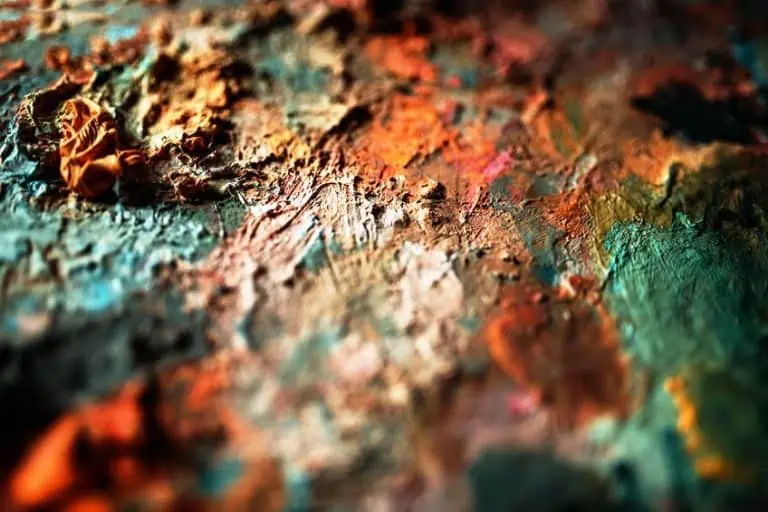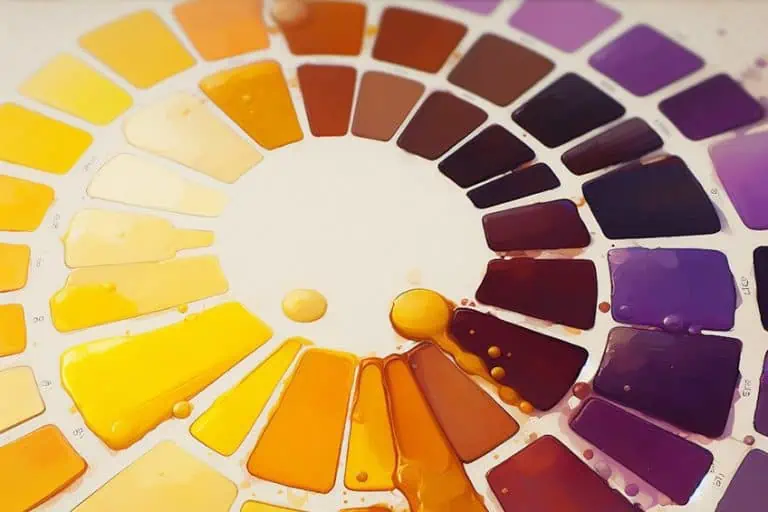Burnt Umber Color – How to Make Burnt Umber Paint Easily
This post may contain affiliate links. We may earn a small commission from purchases made through them, at no additional cost to you.
The burnt umber color can be placed alongside other earth tones like raw umber, yellow ochre, and burnt sienna. These natural earth pigments have been used throughout history from as early as prehistoric times. Some artists seem to have an aversion to burnt umber, but it is a valuable asset to any color palette.
Table of Contents
Interesting Facts About Burnt Umber
The name itself, “umber”, comes from an Italian word and name for the pigment terra d’ombra. Translated this means “earth of Umbria”, which is a region located in Italy where the pigment was first mined. Another link to the color name could also be from the Latin word “umbra”, which means shadow. This is an apt description since it helps to make more dramatic shadows or shading in paintings.
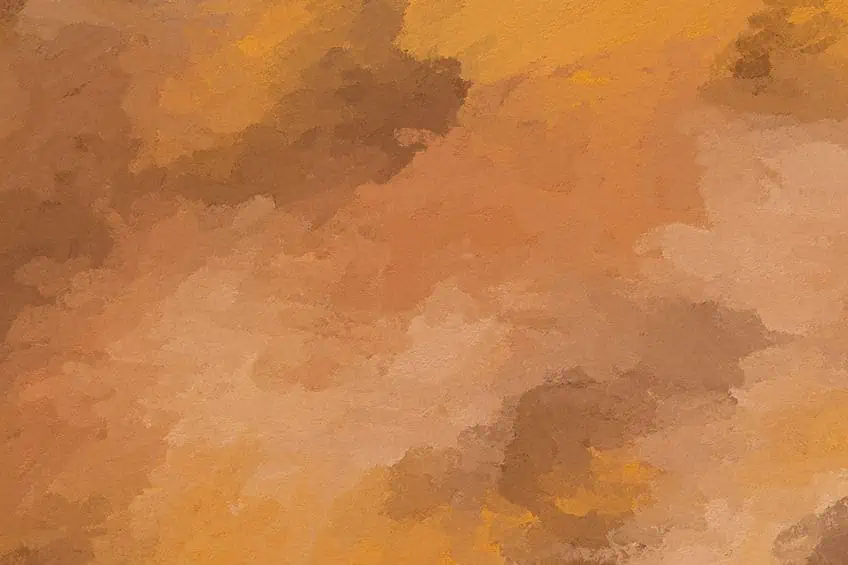
What Is a Burnt Umber Color?
Umber can be described as a natural, cool brown with yellow-brown undertones as it contains iron oxide as well as manganese oxide. As mentioned, umber can be categorized along with sienna and ochre as an earth tone, although umber is darker in color. The higher amounts of manganese oxide are what give it its brownish color. So, where does burnt umber come in?
When it comes to raw umber vs. burnt umber, raw umber is the natural form of pigment. Once “burnt” or heat is used, and all moisture is removed, the color changes to a darker, warmer reddish-brown.
The place where the largest deposits of raw umber can be found is in Cyprus. Umber is not a particular color and can come in a range of different shades and undertones, all depending on the amount of mineral present within the pigment. So, the various umber colors can vary from light to darker tones, with yellowish, red, or gray undertones.
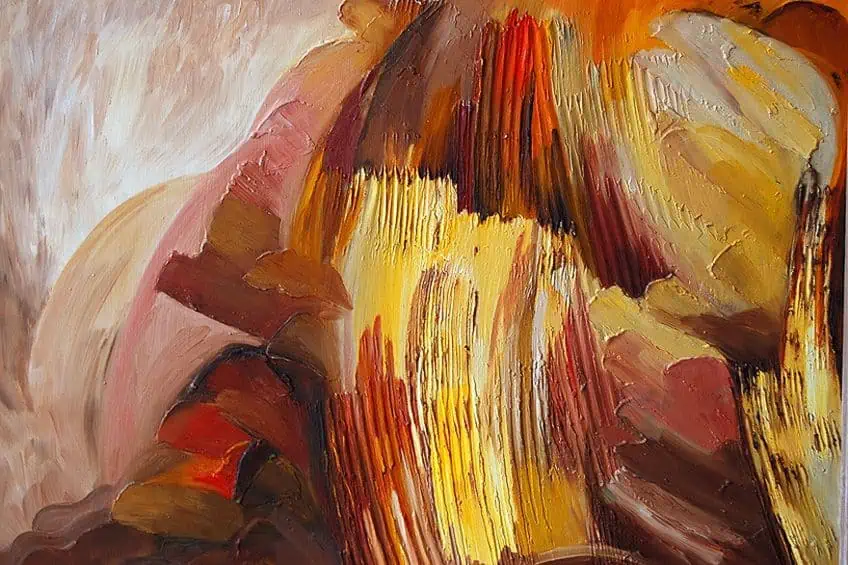
Burnt Umber: A Brief History
Natural earth pigments like burnt umber have been used for thousands of years, the use of burnt umber can be traced back as far as the Neolithic period. In later years, the pigment was found to be abundant in an area known as Umbria, which is in Italy. The pigment was then used by many well-known artists. During the 17th century, during a time known as the Baroque era, the use of burnt umber became quite popular. One of the techniques developed during this time is known as chiaroscuro. This technique was used to create vast contrast between dark and light, which affected the entire composition. Some of the famous artists who incorporated this technique into their paintings were Rembrandt and Caravaggio.

Self Portrait with Two Circles (1665-69) by Rembrandt; Rembrandt, Public domain, via Wikimedia Commons
They used burnt umber to add rich, brown color to their paintings. However, since raw umber contains a natural oxidizing agent like manganese, it dries rather quickly. Artists used this quality and painted groundwork or underpaintings with these pigments so that they could work faster. They also mixed raw umber with other pigments to speed up the drying time. The pigment was also used in combination with ultramarine blue to create deeper and richer shades of black. Below are some famous artists and paintings that used burnt umber.
- Portrait of Jorge Manuel (1603) by El Greco
- Self-portrait with two Circles (1659) by Rembrandt
- Apollo the Lute Player (1665-69) by Caravaggio
- A Dance to the Music of Time (1634-1636) by Nicolas Poussin
- Pictura (1661) by Frans van Mieras
- The Milkmaid (1650) by Johannes Vermeer
The painting by Mieras was used as a representation of what color palette is needed for creating flesh tones. Vermeer used burnt umber to create shadows on the walls since it produced a warmer color than simply using black. Later, in the 20th century, many of the natural pigments were being replaced by synthetic varieties. However, you can still get the natural pigments today.
You will need to check the paint label, if it has the name Brown pigment 7 or the code PBr7, then it is from a natural source.
Burnt Umber Color Tones
Umber can come in several different shades due to its varying mineral content as well as how it is processed. Once heated, the color becomes more vibrant and can become dark brown with yellowish, red, or gray undertones. Below are a few varieties of umber, each with its hex code as well as other relevant codes for web design and printing.
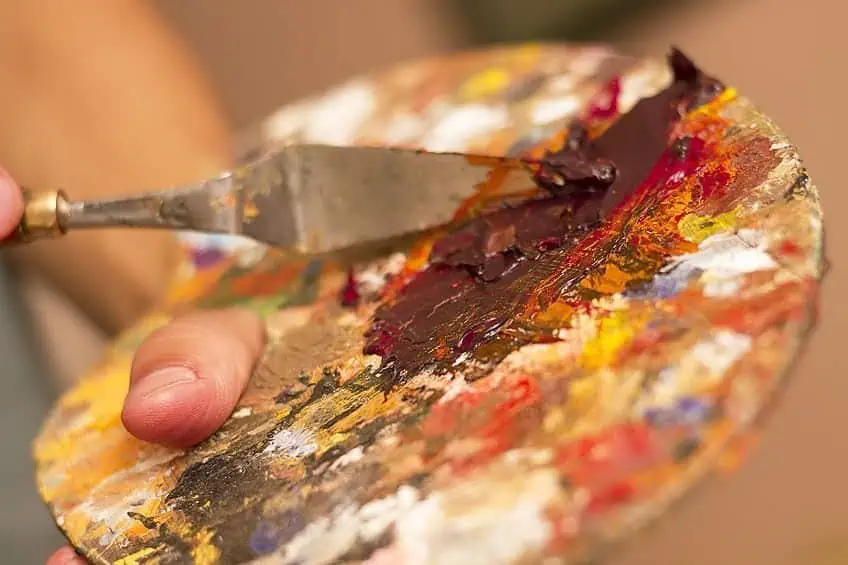
Raw Umber
The real raw umber color leans more towards a cool, yellowish-brown. So, this moderate yellow-brown is as close you are going to get for a raw umber color online. Way back, when web design was only in its infancy, there were only 216 web-safe colors that could be used properly on a monitor. In those days raw umber was not considered a web-safe color.
Today, there are thankfully, no restrictions or limitations concerning colors anymore.
| Umber Shade | Umber Color Hex Code | CMYK Umber Color Code | RGB Umber Color Code | Umber Color |
| Raw Umber | #826644 | 0, 22, 48, 49 | 130, 102, 68 |
Autumn Umber
This can also be seen as a moderate to dark orange, but with a little more red in the mix. These colors are perfect for use in painting scenes, especially the autumn scenes where you will find lots of browns, reds, and orange colors.

| Umber Shade | Umber Color Hex Code | CMYK Umber Color Code | RGB Umber Color Code | Umber Color |
| Autumn Umber | #ae704f | 0, 36, 55, 32 | 174, 112, 79 |
Umber Orange
Umber lies on the color wheel between red and orange. This particular umber color is a dark orange, with brown undertones. Another color that can help portray earth elements in paintings. Many mistake beige, which is more of a light brown, for being part of the umber family.
However, these are separate colors but can be used together in paintings and design.
| Umber Shade | Umber Color Hex Code | CMYK Umber Color Code | RGB Umber Color Code | Umber Color |
| Umber Orange | #a75e09 | 0, 44, 95, 35 | 167, 94, 9 |
Light Umber
A moderate, dark orange color, and almost seem like a chalky earth tone. As with other earth tones, it can be used for interior design to create a warm and welcoming feeling. Try pairing it with beige, tan, and shades of blue for contrast. The color can also be used to create monochromatic underpaintings.
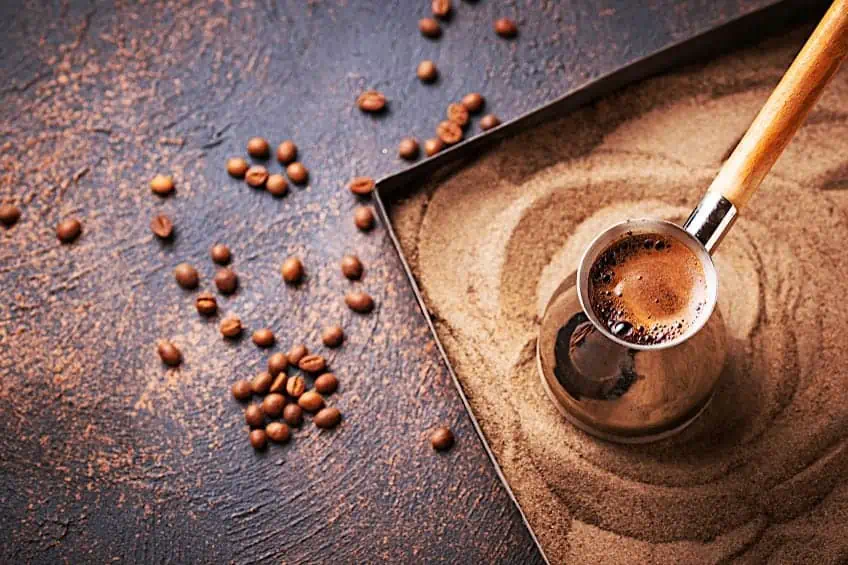
| Umber Shade | Umber Color Hex Code | CMYK Umber Color Code | RGB Umber Color Code | Umber Color |
| Light Umber | #977b4d | 0, 19, 49, 41 | 151, 123, 77 |
Burnt Umber
The name for this specific color was recorded in English during the mid-17th century and is a vibrant reddish-brown color. Since it tends towards red, it can be seen as a more energetic color and can also be associated with activity, passion, taking action, excitement, boldness, as well as aggression.
The color may be used to help entice readers to take some sort of action, for example, purchasing a product.
| Umber Shade | Umber Color Hex Code | CMYK Umber Color Code | RGB Umber Color Code | Umber Color |
| Burnt Umber | #8A3324 | 0, 63, 74, 46 | 138, 51, 36 |
How to Make Burnt Umber
Umber comes in various shades and tones that can be used as a neutral or a bold color, depending on its use. The overall effect is that it is associated with nature and earth, not only for scenes and landscapes but it can also be used in creating various skin tones as well. You can add earth tones like burnt umber to any other color to adjust the tint, making it softer and less intense.
Another popular use for earth tones like burnt umber is to use it as an underpainting. The burnt umber is also often used to darken colors instead of black, providing more warmth to the final color. This is perfect for creating shadows and dark areas within a painting. Try mixing ultramarine blue or cyan with burnt orange to create a dark or gray shade.

Some like to use natural pigment because it dries much more quickly than other pigment colors. However, today you do not only get natural earth pigments, but you also have your synthetic varieties. You can check and find all this information on the label. You can try and create your own raw or burnt umber color, but there are brands and products you can purchase for a more authentic look. Many recommend using the following brands for both raw and burnt umber, Da Vinci and Daniel Smith. There seem to be a few ways you can make burnt umber paint if you do not have a tube laying around. Here are some ideas for both raw and burnt umber. When mixing burnt umber paint, be sure to keep a color palette to compare and keep a record for future use.
- Raw Umber: Take a green color base and mix in equal parts of purple and orange.
- Burnt Umber: Take a blue base color and mix in yellow and small amounts of red. These are your primary colors. Try using ultramarine, or phthalo blue, Hansa Yellow, and naphthol red.
- Burnt Umber: Two parts burnt sienna with one part ultramarine blue or phthalo blue. The phthalo blue should give a darker brownish color.
Designing With Burnt Umber
Earth tones such as burnt umber can be a wonderful interior home color. Burnt umber has more of a warmth to it that provides an inviting feel to a room, even the name has a rustic, yet sophisticated feel to it that reminds you of autumn leaves.
The rich color works even better with other similar earthy tones like beige, tan, espresso, and brown. The darker burnt umber works best with lighter colors, making a nice contrast and highlighting certain areas. Since earthy tones are natural, why not bring in more natural elements into the design. For example, add some greenery with some plants, or use natural décor elements like stone, wood, jute rugs, ceramics, woven baskets, or rattan chairs.

One way to bring in the color of burnt umber without going overboard is to simply paint an accent wall. The other white walls and the burnt umber should create something that is not too overwhelming. Different shades of blue and green can work well with burnt umber. Try combining it with dark blue colors and grays, or to lighten things up try using peach and mint green. Teal is another color that can work well with burnt umber or any shade of orange.
Burnt umber paint, stain, or glaze can also make some amazing furniture pieces that add a more antique look to them. When applying some glaze or stain over an item, it helps to give it a more aged look that can add that special touch to an old piece of furniture. You can also use the paint or stain over metals like steel or bronze, which then gives it a weathered patina look. All you do is dab a bit of paint onto your item with a sponge and then use a soft bristle brush to create an even better look.
You can also do this over a metallic paint finish for similar results.
Fashion Design and Burnt Umber
Since burnt umber is an earth tone, it should work quite well in fashion design. Wearing this shade of color can help to produce a nice contrasting color that has warm undertones. The color works especially well with those who have a darker skin tone. To create a more casual appearance, wear a burnt umber color shirt with denim. For a more formal look, consider a burnt umber dress, which is quite popular as a selection for bridesmaid dresses. The color looks especially sophisticated and elegant against white. Here are a few more fashion ideas.
- Similar tones of burnt orange and green can complement each other in an outfit.
- Make a decadent and bold statement with a combination of burnt umber and gold.

- For a happier and bright combination, swap the gold with yellow.
- To subtly bring burnt umber in, simply accessorize with earrings, a necklace, shoes, or a handbag. You could also choose patterns or prints with the color.
Burnt umber, as with all earth tones might seem to be unpretentious and a color that springs to mind as someone’s favorite. However, there are many ways to successfully use burnt umber color in paintings, design, and fashion.
Frequently Asked Questions
Is Raw Umber Similar to Burnt Umber?
When it comes to raw umber vs. burnt umber, it is a fairly simple explanation, similar to your burnt sienna. The natural pigment is your raw umber, however, once this is heated, it produces your burnt umber. Both of these pigments are slightly different in appearance.
What Color Is Burnt Umber?
The raw umber can be categorized as cooler, with yellowish-brown undertones. Once heated, the burnt umber becomes darker and warmer, with more of a reddish-brown undertone. Pigment color may vary due to the differing amounts of the mineral present.
Uses for Burnt Umber in Painting?
Burnt umber paint has many uses, for example, it is popularly used to create underpaintings. Another use is to darken paints, instead of using black paint. Burnt umber is perfect for landscapes as it goes well with all other earth tones. The color can also be used to create various skin tones. To soften colors and lower color intensity, you can add burnt umber or other earth tones.
Can You Mix Burnt Umber With Your Primary Colors?
Searching for how to make burnt umber? The best option would be to purchase the burnt umber color, available from different brands. However, you can mix your primary colors to get a close approximation of the burnt umber color. Try using ultramarine blue, Hansa yellow, with smaller amounts of naphthol red.
Duncan graduated with a diploma in Film and TV production from CityVarsity in 2018, after which he continued pursuing film while taking on a keen interest in writing along the way. Since having graduated, he began working as a freelance videographer, filming a variety of music videos, fashion and short films, adverts, weddings and more. Throughout this, he’s won a number of awards from various film festivals that are both locally and internationally recognized. However, Duncan still enjoys writing articles in between his filming ventures, appreciating the peace and clarity that comes with it.
His articles focus primarily around helping up-and-coming artists explore the basics of certain colors, how these colors can be paired with other shades, as well as what colors are created when you mix one with another. All while relating these shades to historically significant paintings that have incorporated them into their color palette. As a lover of the arts himself, he takes great interest in the Renaissance era of paintings, an era that has directly inspired many of his favorite films.
Learn more about Duncan van der Merwe and about us.

